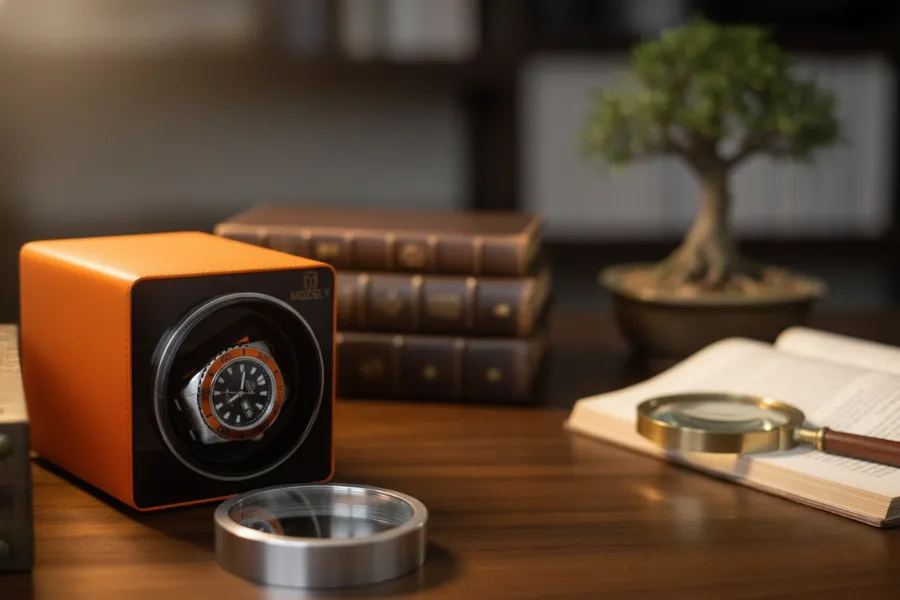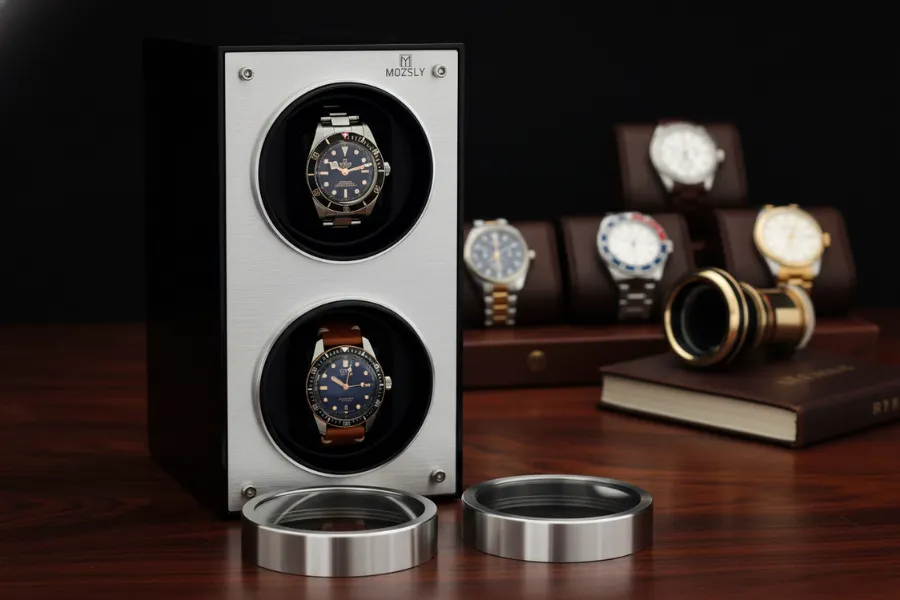Share This Post
Think about pulling a watch from a drawer and finding it stopped or running fast — I’ve been there. Over the past six years, I’ve used and tested watch winders, talked with watchmakers, and set dozens of automatic watches.
I learned settings matter: wrong TPD or direction can cause a stopped watch or extra wear. You don’t need to guess. I’ll walk you step by step, with simple tests and safe starting points, so you can set your automatic watch winder with confidence and keep your watch ready and healthy.
Find Your Watch’s Specific TPD Requirements
First, let’s find what TPD your watch needs.
Quick Reference Chart for Popular Watch Brands
Here’s a simple chart you can scan. These are starting points—not guaranteed exact values for every model. Treat them as a safe place to begin.
| Brand | TPD | Direction |
| Rolex | 650-950 | Bidirectional |
| Omega | 650-800 | Bidirectional |
| ETA / Sellita movements | 650-800 | Bidirectional |
| IWC | 500-950 | Clockwise |
| Seiko | 500-950 | Bidirectional |
| Tudor | 650-800 | Bidirectional |
| Panerai | 650-1800 | depends on movement |
| Jaeger-LeCoultre | 650-950 | Bidirectional |
| Zenith | 650 | Bidirectional |
| Breitling | 650-800 | clockwise or bidirectional depending on caliber |
Remember: these are starting points. Always look up your model or its movement caliber for exact specs.
How to Find Your Watch’s Official Specifications
Step-by-step:
- Find the movement caliber number. Look at the case back, owner’s manual, or product page.
- Search the movement maker: ETA, Sellita, Miyota, Seiko, Rolex, etc.
- Read the technical sheet for that caliber. That sheet often lists rotations needed and direction.
- If the manufacturer page doesn’t say, check brand forums, the owner’s manual, or ask an authorized service center.
Quick tip: If you can’t find specs, don’t panic. About 85% of automatic watches wind bidirectionally, and most need 650–900 TPD as a good starting point.
Understanding Watch Winder Controls and Settings
Let’s demystify the controls so you don’t feel lost in menus.
What TPD Really Means?
TPD = total full rotations the watch winder makes per day. If a watch needs 650 TPD, the watch winder will be programmed to produce that many full turns over 24 hours.
Practical example:
- Suppose a watch winder makes a 10-turn cycle in 30 seconds. To reach 650 turns, it would repeat those cycles until it reaches the daily goal—about every 22 minutes of accumulated turning during the day. Watch winders do this in short bursts, not one long run.
You can think of it as the movement of your wrist when wearing a watch. More turns aren’t always better. The goal is to mimic normal wrist motion, not punish the movement.
Rotation Direction Settings Explained
There are three common settings: clockwise, counterclockwise, and bidirectional (both directions).
Quick breakdown:
- Bidirectional: Most watches (about 85%) wind this way. That means the winding mechanism tightens the mainspring when the rotor spins either way.
- Clockwise-only: Roughly 10% prefer this direction.
- Counterclockwise-only: Around 5% prefer this.
A clock-face analogy helps: imagine the hand moving right (clockwise) or left (counterclockwise). If the watch only winds when the rotor moves right, choose clockwise.
How Watch Winder Winding Cycles Work?
Watch winders run in cycles: they turn for 30 seconds to 2 minutes, then rest. They repeat this throughout the day until they’ve done the programmed TPD. They aren’t running all day.
Example: To reach 650 TPD, a watch winder might run 10-turn bursts several times a day at set intervals. This keeps the watch wound while keeping the wear low.
Step-by-Step Process to Find Perfect Settings
Here’s a simple method I use.
The Conservative Testing Method
- Set your watch winder to bidirectional and 650 TPD.
- Place the watch and run for 48 hours.
- After 48 hours, check timekeeping and whether the watch stopped overnight.
- If it stopped, increase TPD to the next level (for example, 800) and test another 48 hours.
- Repeat until stable.
If it keeps time and doesn’t stop, you’re done.
Testing Different Rotation Directions
If bidirectional didn’t work:
- Try clockwise-only at the same TPD.
- If that fails, try counterclockwise-only.
- Test each setting for 48 hours.
When a direction works, stick with it. You’ll often find that only one direction keeps the mainspring topped properly.
Advanced Troubleshooting for Difficult Watches
Some watches are picky—complications, micro-rotors, or vintage pieces can behave oddly.
If you run into trouble:
- Check how the watch sits on the cushion. Poor seating can prevent effective winding.
- Reduce TPD if you suspect excessive wear.
- For vintage watches or odd movements, consult a watchmaker before long-term use.
- The watch keeps stopping despite many settings: get it serviced. It might have an internal issue, not a winding problem.
If a watch shows repeated problems on any watch winder—electric or manual—it’s time for a professional look.
Red Flags: Signs Your Watch Winder Settings Are Wrong
You don’t need a microscope. Here are obvious signs:
Your Watch Keeps Stopping
Usually, that means not enough TPD or the wrong direction.
Checklist:
- Make sure the watch is seated correctly on the pillow.
- Increase TPD gradually.
- Try different rotation directions.
- If it still stops, see a watchmaker.
Time Accuracy Problems and What They Mean
If the watch runs fast or slow while on the watch winder, it can mean:
- The watch was already due for service (magnetism or lubrication).
- The mainspring is under tension from too many turns (rare).
- The movement may have wear and needs inspection.
Stopping is usually a winding problem. Accuracy drift often means a movement issue beyond the watch winder.
When to Worry About Overwinding
Modern automatic watches have mechanisms to prevent true overwinding. Still, excessive TPD can cause extra wear over many years. Signs to watch for:
- Strange noises.
- Excessive heat.
- Unusual accuracy changes after a long period on the watch winder.
A quality watch winder should avoid overwinding (it counts turns and rests). That’s one reason to pick a reliable unit.
Are watch winders bad for watches? Only if the settings are wrong or the watch already needs service. Choose a quality watch winder and test it carefully.
Mozsly Watch Winder Maintenance and Best Practices
I own a Mozsly watch winder and use it alongside a smaller manual winder. It’s quiet, and its settings are clear. I’m not saying it’s the only good product—just sharing what worked for me.
Essential Maintenance Tasks
- Always turn off the power before inserting or removing watches.
- Clean dust off the pillow and interior monthly with a soft cloth.
- Keep the unit in a dry, cool place.
- If your watch winder uses a Japanese Mabuchi motor, it’s low maintenance, but avoid constant power-on.
Monthly checklist:
- Power off before handling.
- Wipe the interior and pillow.
- Check cushions for wear.
- Test settings once a month if you rotate watches.
Maximizing Your Investment
- Rotate wearing and winding. If you wear a watch daily, you don’t need the watch winder.
- Battery operation usually lasts about 30 days on good units; plan accordingly.
- If you have multiple watches, use a multiple watch winder or switch watches weekly.
- Save sets of settings for each watch if your watch winder allows profiles.
A good watch winder—whether a Mozsly watch winder or another recommended watch winder—should be quiet, reliable, and easy to set.
Conclusion: Your Watch Winder Success Checklist
Here’s the quick checklist:
- Find the movement caliber and check the manufacturer specs when possible.
- Start conservative: 650 TPD, bidirectional.
- Test 48 hours, then adjust slowly.
- Try different directions only if needed.
- Check seating and cleanliness.
- Watch for stopping, strange accuracy shifts, or noise.
- Service the watch if problems continue.
Take care of both the watch and the watch winder. A good auto watch winder, properly set, keeps your watch ready and healthy. If you’re unsure, ask your watchmaker or the brand. I learned this the hard way — a little patience up front saves time and money later. So go on, give your watch the right settings. It’ll thank you.
Related Post's
Featured Video
Provide an email subscription feature for users to sign up for updates.
Follow the world of watches and cigars for exclusive content!
By subscribing to our newsletter, you will be the first to receive notifications of our latest articles, popular posts and special events.








